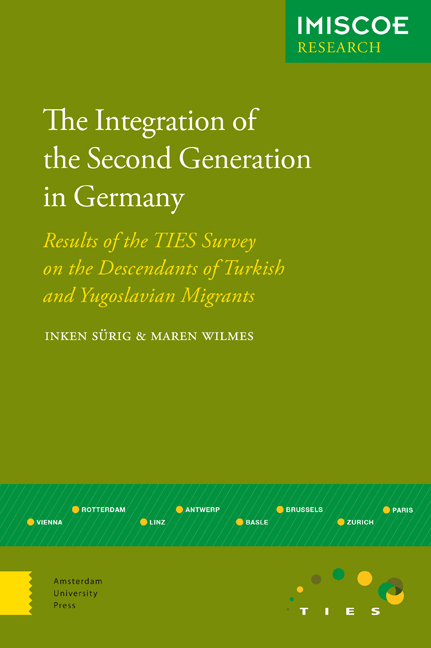 The Integration of the Second Generation in Germany
The Integration of the Second Generation in Germany Book contents
- Frontmatter
- Contents
- Preface: The International Research Project TIES
- 1 Introduction
- 2 Migration History and Basic Demographic Characteristics of the First Generation
- 3 Educational Careers and Educational Outcomes
- 4 Labour Market Positions
- 5 Segregation and Housing
- 6 Ethnic and Cultural Orientations
- 7 Social Relations
- 8 Family Formation and Partner Relationships
- 9 Conclusions and International Comparisons
- References
- Other IMISCOE Research Titles
8 - Family Formation and Partner Relationships
Published online by Cambridge University Press: 11 December 2020
- Frontmatter
- Contents
- Preface: The International Research Project TIES
- 1 Introduction
- 2 Migration History and Basic Demographic Characteristics of the First Generation
- 3 Educational Careers and Educational Outcomes
- 4 Labour Market Positions
- 5 Segregation and Housing
- 6 Ethnic and Cultural Orientations
- 7 Social Relations
- 8 Family Formation and Partner Relationships
- 9 Conclusions and International Comparisons
- References
- Other IMISCOE Research Titles
Summary
Introduction
As the TIES survey group consists of 18- to 35-year-olds, partner relationships in the form of cohabitation and marriage only occur in 40 per cent of cases. Sixty per cent are either living alone or with their family of origin. The conclusions that can be drawn from the TIES survey in this context must therefore be regarded as assessments of the situation as it was at a specific moment, not applying to the majority of the respondents.
As an area of integration, the private sphere of partner relationships and family formation is considered to be of interest in terms of not only intraand intercultural affiliations, but also gender relations and demographic trends. The main focus, however, is on the origin-related composition of partnerships. This is because migrants’ marriages within their own group are often interpreted as evidence of distance from the majority population, while inter-group marriages are credited with more adaptive and integrative capacities (see Beck-Gernsheim 2006; Nauck 2004). In this line of argument, immigrants’ access to a majority group in the country of immigration (through marriage and family) is understood as a yardstick of assimilation (see Esser 2006; Ohliger & Raiser 2005) and as an indicator of the openness or closedness of a society (Klein 2000). This is because structural socio-economic differences between population groups tend to be reproduced and consolidated by means of intra-group family formation, with far-reaching impacts on the next generation. A general tendency towards endogamy in several migrant groups is, besides individual preferences and socio-cultural factors, in large part dependent on demographic and social opportunity structures (see also chapter 6 on ethnic and cultural orientations). It also depends on actual access to certain population groups in socialising contexts such as school or the workplace (Straßburger 2003). Such contexts are also shaped by the attitudes of the majority population (Beck-Gernsheim 2006).
Cohabitation, marriage, and procreation
In Germany a trend towards increasing marital age and declining interest in marriage has been in evidence since the 1970s. Marriage has lost its monopoly as the one legitimate form of partner relationship, and cohabitation has become a commonly practised alternative (Heß-Meining 2004; Lenz 2006). At the same time, birth rates in Germany have declined, and the average age of first-time childbirth is advancing. Late procreation or non-procreation seems to be strongly connected with increasingly unstable partner relationships, economic uncertainties, and long phases of education and career foundation.
- Type
- Chapter
- Information
- The Integration of the Second Generation in GermanyResults of the TIES Survey on the Descendants of Turkish and Yugoslavian Migrants, pp. 169 - 182Publisher: Amsterdam University PressPrint publication year: 2015


